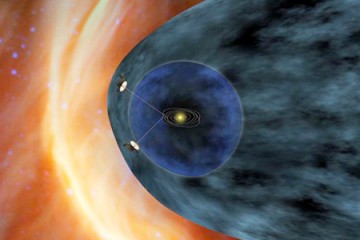In the mid-1970s, an argument arose as engineers at the Jet Propulsion Laboratory were building Voyager 1, a spacecraft designed to fly by Jupiter and Saturn on a four-year mission to gather data from 10 onboard scientific instruments. Stamatios Krimigis wanted one of those instruments to be mechanical. He was principal investigator for the Low-Energy Charged Particle instrument, the LECP, designed to measure the flow of electrons and ions in space, and he wanted to be able to rotate it and change its angle of observation. Engineers do not like mechanical parts on a spacecraft. If the machinery sticks, then what? It is not like you can reach across millions of miles of space and tap it with a wrench. "They said, 'Oh, you're crazy,'" Krimigis recalls. "'This thing is going to get stuck.'"
Krimigis, who has been at the Applied Physics Laboratory since 1968 and directed its Space Department from 1991 to 2004, won the argument, confident that the LECP would not stick. Thirty-five years into Voyager's mission, which NASA long ago extended from the original planetary flyby to an exploration of the farthest regions of the solar system, the instrument still works—still rotates, still takes measurements, still generates data that Voyager sends back to Earth.
And makes trouble, if you are attached to the standard computational models of the border between the sun's atmosphere and interstellar space. According to those models, the cloud of charged particles that the sun continuously blasts into space, the solar wind, forms a bubble called the heliosphere, which has a boundary. At this boundary, said the models, the flow of solar particles would encounter pressure from the flow of particles from the galaxy and the galactic magnetic field, and this would turn the solar wind "northward"— perpendicular to the plane of Earth's orbit, known as the ecliptic. Once Voyager had crossed the boundary, the LECP would stop detecting solar-charged particles and the sun's magnetic field and start picking up cosmic rays and the interstellar magnetic field. Neat and simple.
Until about three years ago, when Voyager's findings began to part company with the standard models. The models predicted a sharp boundary at which the solar wind would change direction. Instead, Voyager found a peculiar zone where the charged particles from the sun had lost almost all velocity, and instead of flowing in a different direction were mingling with interstellar gases. "The solar wind had stopped dead in its tracks," Krimigis says. That was not supposed to happen.
So he asked the flight controllers at the Jet Propulsion Laboratory if they could change the orientation of Voyager so he could position the LECP perpendicular to the ecliptic to gather new data that might explain what he was seeing. The spacecraft had been in the same orientation for more than three decades, and to move it, JPL had to call on Don Johnson, a long-retired engineer who had designed the spacecraft's command system. Johnson was delighted to work on Voyager again and reminded JPL how to do it. "Lo and behold, the spacecraft did exactly what it was supposed to do, after 34 years in space," Krimigis says. By January 2012, after several repeats of this maneuver, the LECP had confirmed there was no flow of charged particles, and no northward deflection. Puzzling.
Three months after the findings had been reported in Nature, the spacecraft found that galactic cosmic rays had jumped 5 percent in intensity. In mid-July, the intensity jumped again and the pressure of the solar wind dropped fivefold. This had been predicted, more or less. But five days later, the changes reversed: cosmic rays down, solar wind up. Says Krimigis, "We knew something brand new was happening." The scientists had been processing Voyager data on a weekly basis. Now they started processing daily. In August, cosmic rays suddenly increased in intensity by 10 percent, and solar particles plummeted a thousandfold, essentially disappearing. Aha, Krimigis thought, Voyager has finally crossed the boundary into interstellar space. "Then the people who measure the magnetic field came in and said, 'But look, the direction of the magnetic field didn't change a whole lot.'" Instead of deflecting northward as predicted, the sun's magnetic field appeared to continue in its usual direction, and what's more, become 10 times stronger. That did not make sense in the context of the standard models, but there it was—the LECP, Krimigis' dependable little machine, had found something no one expected.
Krimigis and his colleagues now think that Voyager may have discovered a previously unsuspected region of space in which the sun's magnetic field does not change direction but links with the interstellar magnetic field to create a sort of magnetic highway; along this highway, solar charged particles stream out and cosmic rays stream in. Another possibility is that what everyone thought about the behavior of the galactic magnetic field has been wrong all along. Krimigis points out that because the field had never been measured directly, computational models may have been built with the wrong numbers. "You think you know what's going to happen," Krimigis says, "and then it doesn't."
As for the prediction that his movable LECP would stick, that has not happened either. Krimigis estimates that by this point, it has moved through 6 million mechanical steps, even though it had been tested only to 500,000. Built to last, like its principal investigator, who is 74 years old and excited every day by what Voyager is finding. "I am absolutely delighted to have lived long enough to see this."
Posted in Science+Technology
Tagged applied physics laboratory, space exploration, nasa, space








